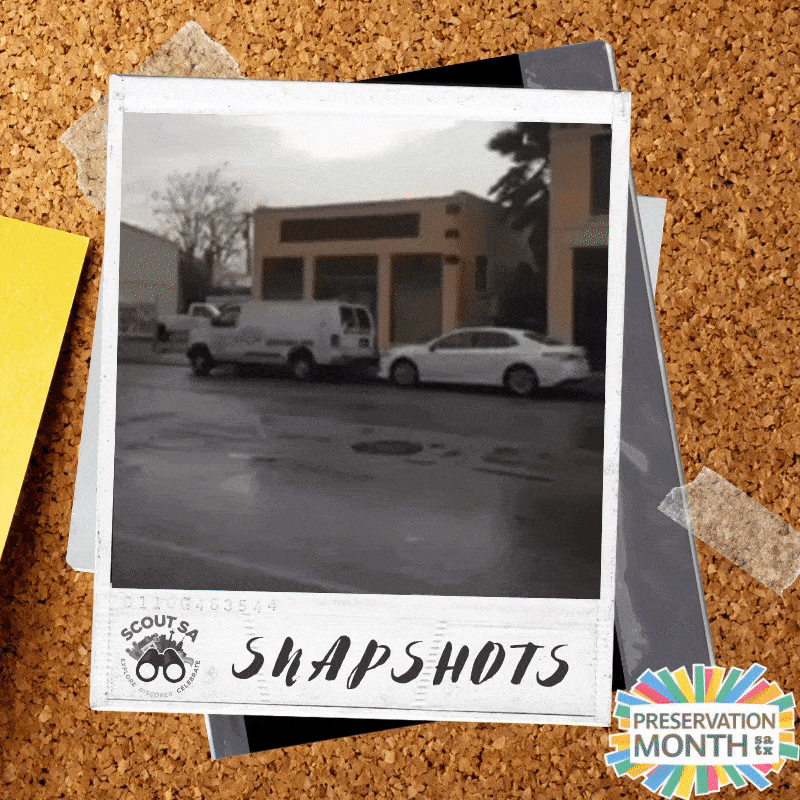The International Plaza shopping center is a community anchor within the Silk Road Cultural Heritage District.
Read MoreRead about changes to the ScoutSA team and our accomplishments over the last year.
Read MoreIn 1936, Grant Elementary School was located at the corner of Elmendorf Street and Delgado Street, and served African American students from San Antonio’s Westside neighborhoods.
Read MoreWhen disaster strikes it can be overwhelming. Do you know what to do before, during, and after an emergency to keep people, pets, and property safe? Use this guide to make a plan and to help you recover.
Read MoreOn April 10, 1952, George W. Church, Sr., opened Church’s Fried Chicken-To-Go at 111 S. Alamo Street, the first of more than 1,600 Church’s Chicken locations worldwide.
Read MoreHappy New Year! Join us in a look back at 2021 as ScoutSA celebrates another year of discovery and exploration of San Antonio’s special places, people, and traditions!
Read MoreEver wonder how genealogists and historians find information about historic places, people, and events in San Antonio? Watch a workshop that reveals the tools of the trade to help anyone become a citizen historian!
Read MoreEdgar Velásquez Reynald joined us during his final semester at St. Mary’s University in 2021. He recently completed a fellowship with the Smithsonian’s Latino Museum Studies Program. Edgar is currently pursuing his PhD in History at Southern Methodist University.
Read MoreThe Art Moderne building at 2603 Broadway was built in 1946 as the Tai Shan Restaurant for Ted and Rose Wu. The Wus were more than successful restauranteurs; though neither were Texans by birth, they worked throughout their lives to support Chinese Americans, their community, and their businesses in San Antonio.
Read MoreIn January 1971, construction began on Alpha Tau Omega’s Roseville Apartments, an affordable housing project on San Antonio’s Eastside designed by Norcell Haywood and funded by the Department of Housing and Urban Development. The sorority, a local chapter of Alpha Kappa Alpha, continues to run the apartment complex, which provides senior citizens with housing and programs to enhance their lives.
Read MoreNorcell Dan Haywood, the first licensed Black architect in San Antonio, shaped our city’s modern aesthetic. He designed community spaces for our historically Black Eastside such as churches, libraries, and community centers, and believed “[Minority architects] should be able to beneficially serve their profession and community at the same time without having to serve one at the expense of the other.”
Read MoreArtemisia Bowden was dean and President Emeritus of St. Philip’s College. She served the school from 1902 until her retirement in 1954 and was canonized by the Episcopal Church for her work in education. In addition to her work with St. Philip’s, Bowden was an active community advocate for San Antonio’s and Texas’ African American residents. Get to know this important civic leader and educator!
Read More2020 was the longest, shortest year. Have you heard this phrase before? When time passes incredibly slowly, but somehow it’s already a new year? It feels like we just published our 2019 year-in-review post, but here we are: it’s already February 2021, and we haven’t reported back to you all ScoutSA learned and shared in 2020.
Read MoreAlicia joined us during her last semester in the Public History program at St. Mary's University. As we transitioned to remote work in March, she demonstrated resilience and professionalism at every turn. We wish her the best in her next adventure!
Read MoreThis spring the ScoutSA team partnered with the Public History program at St. Mary’s University to complete a challenge with 9 students enrolled in a course titled Public History in the Digital Age.
Read MoreThe ScoutSA team will debut a new Snapshot of special places in San Antonio every Friday in May!
Read MoreAs we count down to 2020, we in ScoutSA—the designation, survey, and assessment arm of the Office of Historic Preservation—decided to take some time to reflect on what we’ve accomplished in the last 12 months.
Read MoreScoutSA Intern Angela Gallegos spent several months at OHP working on an innovative project about a unique architectural expression found in many of San Antonio’s historic neighborhoods. Craftsman bungalows can be spotted from Alta Vista to Highland Park, Denver Heights to East French Place. These homes represent a period of rapid residential growth in San Antonio’s early suburbs. Sprinkled throughout these developments are some exceptional properties with unusual features that seem to have been influenced by Asian designs. How did these bungalows come to exist in San Antonio?
Read MoreBeing ScoutSA intern has been such a fantastic experience and I have both learned and contributed so much that it is hard to put it all into words. There is no question about it, I LOVE my job! Where else would I have had the opportunity to have fun being “Preservation Princess” on stage at the Arneson River Theater, or live out a childhood dream of being a “paletera” passing out popsicles to Rehabarama volunteers on a hot day, or have a front row seat to a historic light show under the stars at Mission San Jose?!? While those were fun volunteer experiences outside the office, inside the office there is also never a dull day. I love that I have been given opportunities to work on projects that I was passionate about which utilized strengths in my skillset and also challenged me enough to grow me professionally.
Read MoreHow, then, should we approach preservation of such a pervasive vernacular building type that some might liken to a pox on the landscape, a symbol of our dependence on fossil fuels, places actually designed to prevent us from spending time there? However tempting it may be to equate our modern treatment of these spaces with their historic counterparts, presentism will leave us with smudged windshields and empty tanks when it comes to old service stations.
Read More



















